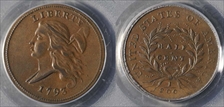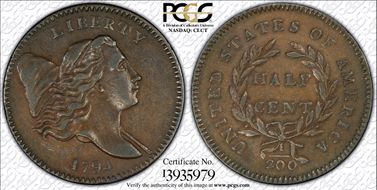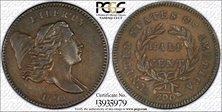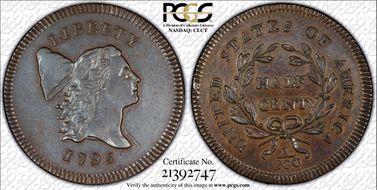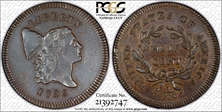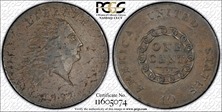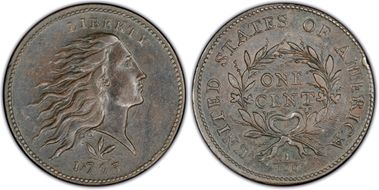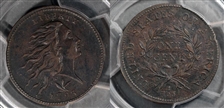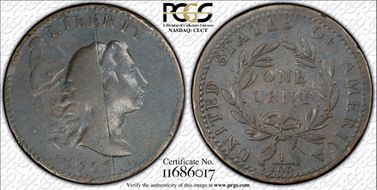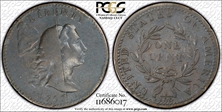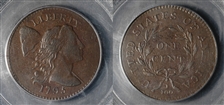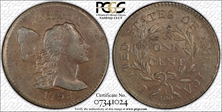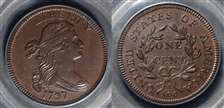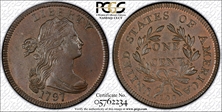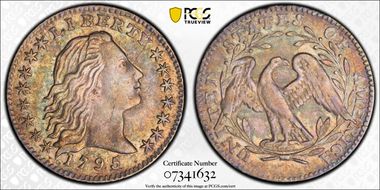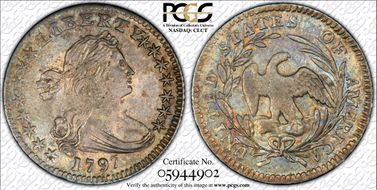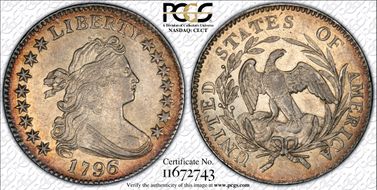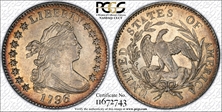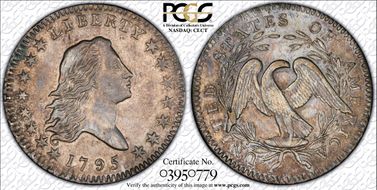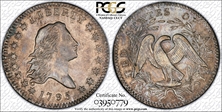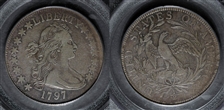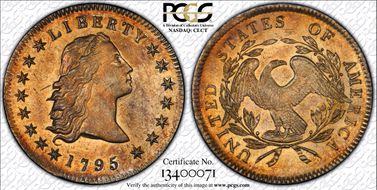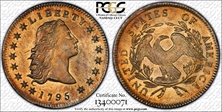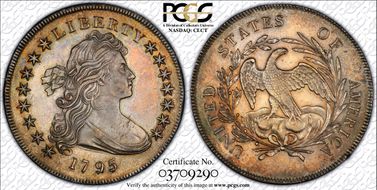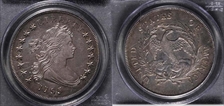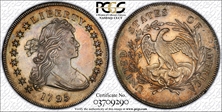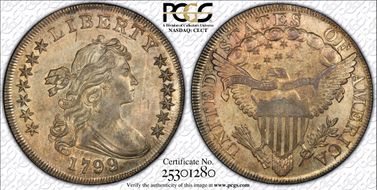Gobrecht's Raisinet Collection 的钱币相册
C-4, B-4, Low R.3. EAC 50, PQ! Manley Die State 2.0, with the die defect atop the 7. This wonderful example of this first year issue has nearly ideal color over smooth, blemish-free surfaces with well-defined, full flowing hair. It's an impressively sharp and smooth representative of this popular single-year type. Chocolate-brown dominates both sides, with a glimpse of deeper brown toning present on the lower left obverse and central reverse. Liberty's cheek and forehead display a hint of friction, but the designs are exquisitely impressed aside from minor softness on some of the letters in AMERICA. Marks are minor for the grade, and the only identifiers are two faint, superficial marks behind the cap, and two blemishes of similar small size below and between AM of AMERICA. These are inconspicuous because of subsequent natural toning, and the quality and beauty of the piece remains irrefutable. Thomas Jefferson made the half cent the lowest denomination in the 1784 “Notes on Coinage” that he submitted to the federal government. Eventually, after much delay and Congressional inaction, Jefferson's proposal emerged as the Mint Act of April 2, 1792. David Rittenhouse, Adam Eckfeldt, and Robert Birch combined to execute the design of the small copper coin with Birch and Joseph Wright engraving the dies. By May 1793 over 30,000 copper half cent planchets had been prepared and on July 20 the Philadelphia Mint coined its first 7,000 specimens. Mint employees produced a further 24,934 pieces on July 26 and the final 3,400 examples on September 18. Having delivered a total of 35,344 1793 half cents, the Mint closed on the latter date so that its staff could flee Philadelphia and its annual yellow fever epidemic.
C-2a, B-2b, High R.2. EAC 40. PQ. The Small Letters Edge subvariety. Evenly struck and undeniably attractive, this sharp golden-brown example boasts plentiful luster within the hair curls and wreath. A tiny obverse rim nick at 9 o'clock will be missed by most observers, and a minor gray spot precedes the U in UNITED.
C-2a, B-2b, High R.2. EAC 40. PQ. The Small Letters Edge subvariety. Evenly struck and undeniably attractive, this sharp golden-brown example boasts plentiful luster within the hair curls and wreath. A tiny obverse rim nick at 9 o'clock will be missed by most observers, and a minor gray spot precedes the U in UNITED.
1795 1/2 C Lettered Edge AU55 C-1, B-1, R.2. Toned a medium to dark brown in color and quite even. The strike is sharp throughout, quite an event as so many of the 1795 half cents come with poorly struck devices. Excellent surfaces are the rule, and this piece is a delight to study. There is a very faint scratch down Liberty's face below her eye, and for identification purposes a tiny planchet flake resides above the post of the E in STATES. A very scarce coin in this relatively lofty grade, with a high quality planchet and good overall eye appeal. From The Melrose Bay Collection
1795 1/2 C Lettered Edge AU55 C-1, B-1, R.2. Toned a medium to dark brown in color and quite even. The strike is sharp throughout, quite an event as so many of the 1795 half cents come with poorly struck devices. Excellent surfaces are the rule, and this piece is a delight to study. There is a very faint scratch down Liberty's face below her eye, and for identification purposes a tiny planchet flake resides above the post of the E in STATES. A very scarce coin in this relatively lofty grade, with a high quality planchet and good overall eye appeal. From The Melrose Bay Collection
1793 Chain 1C AMERICA AU53. S-3, B-4, Low R.3. EAC 40. Surfaces: The obverse surface has countless minute defects that appear to be almost entirely planchet flaws, representing an improperly refined strip of copper, a common problem in the first year of Mint operations. Sheet copper was not yet available from England, so available copper was scrap copper from local sources that Henry Voigt acquired. In his Encyclopedia of Large Cents, Breen discussed the problems with this locally available copper: "Scrap copper varied greatly in homogeneity, density, malleability, and hardness. This is partly from different trace elements and partly from the way the individual lumps had been treated in manufacture. This was a most unsatisfactory expedient; the coiner's department learned quickly that different ingots cast from it varied greatly , with far too many gas bubbles. Strip rolled from these ingots came out with too many cavities and laminations. Many surviving Chain cents accordingly show such flaws." The sophisticated collector will appreciate the planchet flaws as part of this coin's history and charm. A few tiny rim bumps are visible, and these appear to be the only post-strike imperfections. In direct opposition to the obverse, the reverse surface is nearly flawless. Only a few minute defects, rim flaws, and abrasions can be seen. Both sides have lovely medium brown color with traces of darker steel color on the high points. Considerable original mint frost remains, with splashes of lighter tan on the reverse, faded from original mint red. This example is a later die state. The obverse has prominent clash marks around and below the bust, and the reverse is flowlined with field roughening below UNITED STATES. The latest known die state of this variety, called Die State III in Breen's classification, displays heavy clash marks along Liberty's lips, chin, neck, and bust line. Breen suggested that these obverse clash marks, as seen somewhat on this example, were responsible for the "Liberty in chains epithet" sometimes given to the Chain cents. The Chain design was intended to show strength or unity of our new nation. Instead, the device was interpreted by many as representing slavery. Most of the mintage was lost or destroyed, so survivors are of various grades, usually lower quality. Porous or corroded pieces are frequently encountered. There is no question among specialists that Sheldon-3 is the most common Chain cent. Current rarity ratings for the Chain cent varieties suggest that the total surviving population of all varieties is 900 to 1,000 coins, with 400 to 500 examples of the S-3 and about 500 to 600 of all other varieties combined. Working under the assumption that the current rarity ratings are reasonably accurate, we can surmise that the original mintage occurred in about the same proportion. Approximately 18,000 examples of this die marriage were coined, with another 18,000 of the other three Sheldon numbers.
S-9, B-12, R.2. Noyes VF20; tied for CC-21. EAC VF25. PQ–. Variety: Horizontal stem parallel to the date. The bow is large and rounded. The obverse appears on S-8, S-9, and NC-4. The reverse appears on S-9. Vine and Bars Edge. The S-9 is the single most common Wreath cent variety by a wide margin. Surfaces: An attractive piece with smooth, hard, glossy surfaces. Both sides have mottled golden-brown and deep steel color. A few minor handling marks are visible on the obverse, with a small reverse edge bump over the M. Light corrosion is evident, primarily on the reverse. Full obverse and reverse borders are visible, with the reverse imperfectly centered. Both sides are sharply detailed, and the obverse and reverse types stand boldly against the field. Die State VII: The reverse has die cracks through R and CA of AMERICA, and from the left stem through UNIT. A late die state, although most of the individual die defects Breen describes are faintly visible. Census: Perhaps 10 examples are known in Mint State. This piece has considerable sharpness but is downgraded for various minor imperfections. Commentary: The S-9 is clearly the most common Wreath cent variety, and the only 1793 large cent of any design with a rarity rating less than R.3. Sheldon mentioned in Early American Cents that S.H. Chapman considered this variety to represent 35% of all existing Wreath cents. From a mintage of 63,353 Wreath cents, this would imply a "mintage" of about 22,000 coins. Raw material for copper coinage at the new Mint came from a variety of local sources, none particularly ideal, generally consisting of scrap, rough ingots, or sheet. In Breen's Large Cent Encyclopedia, contributor Craig Sholley wrote: "The locally obtained scrap proved to be especially troublesome. Copper is a difficult metal to properly melt and it is far more difficult to roll than silver or gold. The Mint, lacking both experience and proper equipment, was not prepared for either of these operations." The first of the two processes required that Mint personnel melt the metal and pour it into ingot molds, while watching for retained gas bubbles or impurities. Bubbles in the metal resulted in split planchets, laminations, or other defects to the finished coins. Impurities resulted in various streaks or discoloration spots. The other process was rolling the ingots into planchet strip of the appropriate width and thickness. The Mint used horsepower-operated rollers that were apparently poorly made. Coinage of the Wreath cents was suspended after the April 19 delivery while the rollers were repaired.
S-9, B-12, R.2. Noyes VF20; tied for CC-21. EAC VF25. PQ–. Variety: Horizontal stem parallel to the date. The bow is large and rounded. The obverse appears on S-8, S-9, and NC-4. The reverse appears on S-9. Vine and Bars Edge. The S-9 is the single most common Wreath cent variety by a wide margin. Surfaces: An attractive piece with smooth, hard, glossy surfaces. Both sides have mottled golden-brown and deep steel color. A few minor handling marks are visible on the obverse, with a small reverse edge bump over the M. Light corrosion is evident, primarily on the reverse. Full obverse and reverse borders are visible, with the reverse imperfectly centered. Both sides are sharply detailed, and the obverse and reverse types stand boldly against the field. Die State VII: The reverse has die cracks through R and CA of AMERICA, and from the left stem through UNIT. A late die state, although most of the individual die defects Breen describes are faintly visible. Census: Perhaps 10 examples are known in Mint State. This piece has considerable sharpness but is downgraded for various minor imperfections. Commentary: The S-9 is clearly the most common Wreath cent variety, and the only 1793 large cent of any design with a rarity rating less than R.3. Sheldon mentioned in Early American Cents that S.H. Chapman considered this variety to represent 35% of all existing Wreath cents. From a mintage of 63,353 Wreath cents, this would imply a "mintage" of about 22,000 coins. Raw material for copper coinage at the new Mint came from a variety of local sources, none particularly ideal, generally consisting of scrap, rough ingots, or sheet. In Breen's Large Cent Encyclopedia, contributor Craig Sholley wrote: "The locally obtained scrap proved to be especially troublesome. Copper is a difficult metal to properly melt and it is far more difficult to roll than silver or gold. The Mint, lacking both experience and proper equipment, was not prepared for either of these operations." The first of the two processes required that Mint personnel melt the metal and pour it into ingot molds, while watching for retained gas bubbles or impurities. Bubbles in the metal resulted in split planchets, laminations, or other defects to the finished coins. Impurities resulted in various streaks or discoloration spots. The other process was rolling the ingots into planchet strip of the appropriate width and thickness. The Mint used horsepower-operated rollers that were apparently poorly made. Coinage of the Wreath cents was suspended after the April 19 delivery while the rollers were repaired.
S-14 Low R.5, EAC 20. While the Chain and Wreath Cents boast the cachet of single year type status, it is the Liberty Cap design that is the scarcest for the year. Walter Breen estimated that only 250 Liberty Cap cents dated 1793 exist in all grades and of all varieties. The Sheldon-14 is an unmistakable, “naked eye” variety which can be identified at arms length by the spectacular, rim-to-rim die crack down the middle of the obverse. This is the famous Bisecting Crack variety, with a constant and readily visible (usually) vertical die crack on the obverse, from the E of LIBERTY to the 3 in the date. The crack passes through Liberty's earlobe, and almost perfectly divides the obverse in half, slightly favoring the right side. The elusiveness of this particular variety can, in large measure, be attributed to the obvious broken die, from which relatively few coins could have been struck before it finally had to be replaced. With a surviving population of about 70 pieces, the Bisecting Crack is the second most common variety of the six 1793 Liberty Caps, although it is substantially rarer than Sheldon-13. The rarity of this variety has remained essentially unchanged since 1949, when Sheldon gave it an R.5 rating. Perhaps the stable rarity rating is due to the recognizable nature of the obverse. A completed coinage die was not ready for use until it was hardened. The February 1826 issue of The Franklin Journal described the hardening process, quoted in Breen's Large Cent Encyclopedia: "The general method of hardening this metal is to heat it red hot, and then plunge it into cold water, and sometimes into mercury, in order to reduce its temperature as quickly as possible." Craig Sholley notes that the hardening process was the "moment of truth" once a die was engraved. Many dies cracked or shattered during the process. Others only hardened near the edges, and cracked or broke upon first use. It was the results of this procedure, according to Sholley, that have often been described as "poor die steel." There is little doubt that the hardening process resulted in the Bisecting Crack variety.
S-14 Low R.5, EAC 20. While the Chain and Wreath Cents boast the cachet of single year type status, it is the Liberty Cap design that is the scarcest for the year. Walter Breen estimated that only 250 Liberty Cap cents dated 1793 exist in all grades and of all varieties. The Sheldon-14 is an unmistakable, “naked eye” variety which can be identified at arms length by the spectacular, rim-to-rim die crack down the middle of the obverse. This is the famous Bisecting Crack variety, with a constant and readily visible (usually) vertical die crack on the obverse, from the E of LIBERTY to the 3 in the date. The crack passes through Liberty's earlobe, and almost perfectly divides the obverse in half, slightly favoring the right side. The elusiveness of this particular variety can, in large measure, be attributed to the obvious broken die, from which relatively few coins could have been struck before it finally had to be replaced. With a surviving population of about 70 pieces, the Bisecting Crack is the second most common variety of the six 1793 Liberty Caps, although it is substantially rarer than Sheldon-13. The rarity of this variety has remained essentially unchanged since 1949, when Sheldon gave it an R.5 rating. Perhaps the stable rarity rating is due to the recognizable nature of the obverse. A completed coinage die was not ready for use until it was hardened. The February 1826 issue of The Franklin Journal described the hardening process, quoted in Breen's Large Cent Encyclopedia: "The general method of hardening this metal is to heat it red hot, and then plunge it into cold water, and sometimes into mercury, in order to reduce its temperature as quickly as possible." Craig Sholley notes that the hardening process was the "moment of truth" once a die was engraved. Many dies cracked or shattered during the process. Others only hardened near the edges, and cracked or broke upon first use. It was the results of this procedure, according to Sholley, that have often been described as "poor die steel." There is little doubt that the hardening process resulted in the Bisecting Crack variety.
1795 1C Plain Edge AU58 S-78, B-8, R.1. This is one of the most common of all Liberty Cap large cent varieties and an ideal candidate for the date or type collector. For this die pairing, the peak of the 5 in the date just touches the bust truncation. Date and LIBERTY are closely spaced. ONE CENT is centered in the wreath and widely separated. ONE CENT is high in the wreath, as the engraver avoided placing CENT within the narrow space between the lower leaves, and the E in STATES is entered high. Specialists of 1795 cents know that the two most common varieties are S-76b and S-78, both Plain Edge varieties. The Lettered Edge varieties are significantly scarcer, as indicated by Guide Book prices. While none of the three collectible Plain Edge 1795 cent die pairs can be considered more than scarce, the type is more in-demand than the supply can handle, especially for better conditions such as Choice AU.
1795 1C Plain Edge AU58 S-78, B-8, R.1. This is one of the most common of all Liberty Cap large cent varieties and an ideal candidate for the date or type collector. For this die pairing, the peak of the 5 in the date just touches the bust truncation. Date and LIBERTY are closely spaced. ONE CENT is centered in the wreath and widely separated. ONE CENT is high in the wreath, as the engraver avoided placing CENT within the narrow space between the lower leaves, and the E in STATES is entered high. Specialists of 1795 cents know that the two most common varieties are S-76b and S-78, both Plain Edge varieties. The Lettered Edge varieties are significantly scarcer, as indicated by Guide Book prices. While none of the three collectible Plain Edge 1795 cent die pairs can be considered more than scarce, the type is more in-demand than the supply can handle, especially for better conditions such as Choice AU.
1795 1C Plain Edge AU58 S-78, B-8, R.1. This is one of the most common of all Liberty Cap large cent varieties and an ideal candidate for the date or type collector. For this die pairing, the peak of the 5 in the date just touches the bust truncation. Date and LIBERTY are closely spaced. ONE CENT is centered in the wreath and widely separated. ONE CENT is high in the wreath, as the engraver avoided placing CENT within the narrow space between the lower leaves, and the E in STATES is entered high. Specialists of 1795 cents know that the two most common varieties are S-76b and S-78, both Plain Edge varieties. The Lettered Edge varieties are significantly scarcer, as indicated by Guide Book prices. While none of the three collectible Plain Edge 1795 cent die pairs can be considered more than scarce, the type is more in-demand than the supply can handle, especially for better conditions such as Choice AU.
1797 1C Reverse of 1797, Stems, S-123, B-12, R.4 MS64BN. This coin probably traces its origin back to the Nichols find, which included many Mint State examples of this scarce variety. Sheldon-123 is one of three varieties (the other two are S-119 and S-135) made collectible in Uncirculated grades due to the Nichols Find. However, a glance at third party populations confirms that quality examples are rare by the standards of most U.S. series. This is the second of the three varieties attributed to the Nichols Find, with an extremely close date, six berries in each branch, and the final 0 high. The obverse appears on S-122, S-123, NC-2, and NC-3. The reverse appears on 1796 S-119 and 1797 S-123. There is a tiny cut (die chip) on Liberty's cheek below the eye--a diagnostic feature of this S-123--which identifies this Nichols Find variety, which is usually found in or near Mint State grades. At least 10 examples of this variety are known in Mint State, and many more just miss that level, usually with full Mint State sharpness and minor deductions for slight imperfections. Considered R.4, meaning between 80 and 200 examples survive, well over half of the known examples grade AU or better. In fact, the variety would probably be a solid R.5 or perhaps even R.6 if that hoard never existed. Like nearly all coins from the Nichols Find, the surfaces of both sides are a pleasing medium brown with slightly reflective fields. This exceptionally well struck, orange-brown example has unusually smooth surfaces and excellent eye appeal.
1797 1C Reverse of 1797, Stems, S-123, B-12, R.4 MS64BN. This coin probably traces its origin back to the Nichols find, which included many Mint State examples of this scarce variety. Sheldon-123 is one of three varieties (the other two are S-119 and S-135) made collectible in Uncirculated grades due to the Nichols Find. However, a glance at third party populations confirms that quality examples are rare by the standards of most U.S. series. This is the second of the three varieties attributed to the Nichols Find, with an extremely close date, six berries in each branch, and the final 0 high. The obverse appears on S-122, S-123, NC-2, and NC-3. The reverse appears on 1796 S-119 and 1797 S-123. There is a tiny cut (die chip) on Liberty's cheek below the eye--a diagnostic feature of this S-123--which identifies this Nichols Find variety, which is usually found in or near Mint State grades. At least 10 examples of this variety are known in Mint State, and many more just miss that level, usually with full Mint State sharpness and minor deductions for slight imperfections. Considered R.4, meaning between 80 and 200 examples survive, well over half of the known examples grade AU or better. In fact, the variety would probably be a solid R.5 or perhaps even R.6 if that hoard never existed. Like nearly all coins from the Nichols Find, the surfaces of both sides are a pleasing medium brown with slightly reflective fields. This exceptionally well struck, orange-brown example has unusually smooth surfaces and excellent eye appeal.
1797 1C Reverse of 1797, Stems, S-123, B-12, R.4 MS64BN. This coin probably traces its origin back to the Nichols find, which included many Mint State examples of this scarce variety. Sheldon-123 is one of three varieties (the other two are S-119 and S-135) made collectible in Uncirculated grades due to the Nichols Find. However, a glance at third party populations confirms that quality examples are rare by the standards of most U.S. series. This is the second of the three varieties attributed to the Nichols Find, with an extremely close date, six berries in each branch, and the final 0 high. The obverse appears on S-122, S-123, NC-2, and NC-3. The reverse appears on 1796 S-119 and 1797 S-123. There is a tiny cut (die chip) on Liberty's cheek below the eye--a diagnostic feature of this S-123--which identifies this Nichols Find variety, which is usually found in or near Mint State grades. At least 10 examples of this variety are known in Mint State, and many more just miss that level, usually with full Mint State sharpness and minor deductions for slight imperfections. Considered R.4, meaning between 80 and 200 examples survive, well over half of the known examples grade AU or better. In fact, the variety would probably be a solid R.5 or perhaps even R.6 if that hoard never existed. Like nearly all coins from the Nichols Find, the surfaces of both sides are a pleasing medium brown with slightly reflective fields. This exceptionally well struck, orange-brown example has unusually smooth surfaces and excellent eye appeal.
Lots of detail for VF25, Old Green Holder, R.4 PQ A large question surrounding this coin is whether or not President Washington supplied the silver. Research by Joel Orosz and Carl Herkowitz published in the 2003 Amer. Journal of Numismatics cited a memorandum by John A. McAllister, Jr. who related his interview with Chief Coiner Adam Eckfeldt: "In conversation with Mr. Adam Eckfeldt (Apr. 9, 1844) at the Mint, he informed me that the Half Dismes...were struck, expressly for Gen. Washington, to the extent of One Hundred Dollars, which sum he deposited in Bullion or Coin, for the purpose. Mr. E. thinks that Gen. W. distributed them as presents. Some were sent to Europe, but the greater number, he believes, were given to friends of Gen. W. in Virginia. No more of them were ever coined." Eric von Klinger in a June 13, 2005 Coin World review of the article entitled "Document Details Half Disme: Confirms that G. Washington was Source of Silver," wrote: "General Washington did indeed deposit silver for the 1792 half dismes." Orosz responded in a July 4, 2005 letter to the editor that: "We never claim in our article that we have proved that President Washington provided the silver used to strike the half dismes, as both the headline and the first sentence of von Klinger's article flatly state. In our article, we conclude that while the great preponderance of the evidence points toward Washington as the silver provider, the pieces of evidence that could prove he was - Washington's diary for 1792 and Acting Chief Coiner Henry Voigt's July 1792 account book - are unavailable. Washington was a long-time diarist, but the press of his presidential duties prevented him from keeping a diary in 1792. Voigt did keep an account book, but it was lost about a century ago, and no one knows where it is, or if it even still exists. Therefore, while the authors believe that all of the available evidence points to Washington, we cannot prove he was the donor beyond the shadow of a doubt."
1795 H10C MS62. V-5, LM-8, R.3. The years 1795 and 1796 were busy and productive ones for the fledgling U.S. Mint. Director Henry DeSaussure--continuing his dual missions to produce circulating gold coinage and to improve the design of circulating silver coinage--employed the noted portraitist Gilbert Stuart in the summer of 1795 to fashion a new portrait of Liberty to replace the unpopular Flowing Hair design on silver denominations. From those sketches, artist John Eckstein prepared obverse device punches, and Chief Engraver Robert Scot prepared dies conforming to the Mint Act of 1792. The new Draped Bust, Small Eagle design was introduced first in 1795 on the silver dollar. Although no 1795 half dimes with the Draped Bust motif were coined, a 1795-dated obverse die of the new design was produced. The recorded mintage of 86,416 half dimes included both 1794- and 1795-dated pieces, but about three times as many 1795 pieces have been certified. The mintage of 1795 half dimes was divided into 10 different die marriages, most of them quite scarce. This coin is a representative of the scarce LM-8 variety. It is identifiable by the position of star 1 between curls 1 and 2 on the obverse and the wreath with no berries under the left wing of the eagle on the reverse. The LM-8 variety is one of the more available marriages, and is a popular choice with early type collectors. The number of high quality LM-8 half dimes is explained by its presence in a hoard mentioned by Walter Breen in his Proof Encyclopedia of more than 100 Mint State Flowing Hair half dimes, of this and two other varieties, discovered in the 1870s and dispersed by William Elliot Woodward around 1880, known as the Wadsworth-Rea hoard. On this variety there are seven curls, the first star points between curls 2 and 3, and the reverse shows the berries arranged 3-4 with none beneath the wings. There is no berry inside or outside of the U in UNITED, and a spike protrudes from the wreath and points between the first T and A of STATES. The bold diagnostic obverse die crack extends from the upper rim to Y in LIBERTY to the nose and then across the neck to the top of the 7 in the date. This variety is most easily attributed by the lack of berries around the lower left portion of the wreath and the relative position of the lowest outside left leaf relative to the U in UNITED. The die crack through the Y in LIBERTY also confirms this die pairing. The present example is sharper than most and centered, normally not seen on most early Bust design half dimes. No adjustment marks are apparent on either side of this coin.
1795 H10C MS62. V-5, LM-8, R.3. The years 1795 and 1796 were busy and productive ones for the fledgling U.S. Mint. Director Henry DeSaussure--continuing his dual missions to produce circulating gold coinage and to improve the design of circulating silver coinage--employed the noted portraitist Gilbert Stuart in the summer of 1795 to fashion a new portrait of Liberty to replace the unpopular Flowing Hair design on silver denominations. From those sketches, artist John Eckstein prepared obverse device punches, and Chief Engraver Robert Scot prepared dies conforming to the Mint Act of 1792. The new Draped Bust, Small Eagle design was introduced first in 1795 on the silver dollar. Although no 1795 half dimes with the Draped Bust motif were coined, a 1795-dated obverse die of the new design was produced. The recorded mintage of 86,416 half dimes included both 1794- and 1795-dated pieces, but about three times as many 1795 pieces have been certified. The mintage of 1795 half dimes was divided into 10 different die marriages, most of them quite scarce. This coin is a representative of the scarce LM-8 variety. It is identifiable by the position of star 1 between curls 1 and 2 on the obverse and the wreath with no berries under the left wing of the eagle on the reverse. The LM-8 variety is one of the more available marriages, and is a popular choice with early type collectors. The number of high quality LM-8 half dimes is explained by its presence in a hoard mentioned by Walter Breen in his Proof Encyclopedia of more than 100 Mint State Flowing Hair half dimes, of this and two other varieties, discovered in the 1870s and dispersed by William Elliot Woodward around 1880, known as the Wadsworth-Rea hoard. On this variety there are seven curls, the first star points between curls 2 and 3, and the reverse shows the berries arranged 3-4 with none beneath the wings. There is no berry inside or outside of the U in UNITED, and a spike protrudes from the wreath and points between the first T and A of STATES. The bold diagnostic obverse die crack extends from the upper rim to Y in LIBERTY to the nose and then across the neck to the top of the 7 in the date. This variety is most easily attributed by the lack of berries around the lower left portion of the wreath and the relative position of the lowest outside left leaf relative to the U in UNITED. The die crack through the Y in LIBERTY also confirms this die pairing. The present example is sharper than most and centered, normally not seen on most early Bust design half dimes. No adjustment marks are apparent on either side of this coin.
LM-1, V-2, R.3. PQ. Not a trace of wear can be found on this impressive Mint State example, despite blunt central obverse and reverse details. The strike of this piece is typical of nearly every example, and is a direct result of opposing design motifs on the obverse and reverse dies. The eagle on the reverse represents the deepest portion of that die, and it is directly opposite the center of Liberty on the obverse, and these two features competed for metal flow when the coin was struck. Note that the portions of either die that are opposite the blank fields on the opposite side have extremely sharp definition. The surfaces of this piece have satiny luster with reflective fields beneath lovely gray-gold and iridescent toning.
LM-1, V-2, R.3. PQ. Not a trace of wear can be found on this impressive Mint State example, despite blunt central obverse and reverse details. The strike of this piece is typical of nearly every example, and is a direct result of opposing design motifs on the obverse and reverse dies. The eagle on the reverse represents the deepest portion of that die, and it is directly opposite the center of Liberty on the obverse, and these two features competed for metal flow when the coin was struck. Note that the portions of either die that are opposite the blank fields on the opposite side have extremely sharp definition. The surfaces of this piece have satiny luster with reflective fields beneath lovely gray-gold and iridescent toning.
JR-4. Rarity-4. PQ. A coin with strong eye appeal, reflective fields and frosty devices. A bright and attractive dime that has delicate peripheral gold toning starting to form around the edges, with the centers light silver-gray. The strike was sharp as nearly always seen on 1796 dimes, with strong separation on Liberty's uppermost curls and most of the eagle's breast feathers still surviving. Faint, nearly horizontal adjustment marks can be discerned crossing through Liberty’s central curls and neck. Middle die state with the usual thin crack through the first star to the second curl on Liberty, no signs of clashing, and another crack on the reverse left of first S of STATES. Identifiable by a tiny edge scrape above the eighth star and another above the first A of AMERICA. First year of issue for the denomination, and a two year type coin. The Mint coined its first silver dimes and quarters in 1796, and the first gold quarter eagles made their appearance. In 1796 the new design was employed on all five silver denominations, from half dimes through silver dollars. Many of these new coins and new designs were produced in extremely limited numbers, and the year overall is notable for producing some of the rarest U.S. type coins.
JR-4. Rarity-4. PQ. A coin with strong eye appeal, reflective fields and frosty devices. A bright and attractive dime that has delicate peripheral gold toning starting to form around the edges, with the centers light silver-gray. The strike was sharp as nearly always seen on 1796 dimes, with strong separation on Liberty's uppermost curls and most of the eagle's breast feathers still surviving. Faint, nearly horizontal adjustment marks can be discerned crossing through Liberty’s central curls and neck. Middle die state with the usual thin crack through the first star to the second curl on Liberty, no signs of clashing, and another crack on the reverse left of first S of STATES. Identifiable by a tiny edge scrape above the eighth star and another above the first A of AMERICA. First year of issue for the denomination, and a two year type coin. The Mint coined its first silver dimes and quarters in 1796, and the first gold quarter eagles made their appearance. In 1796 the new design was employed on all five silver denominations, from half dimes through silver dollars. Many of these new coins and new designs were produced in extremely limited numbers, and the year overall is notable for producing some of the rarest U.S. type coins.
1798 10C Large 8 AU55 JR-4, R.3. The large 8 in the date is diagnostic for the obverse and for the die pairing by extension. The lone Large 8 variety, represented here by an apparently very early die state, with the obverse die crack from the rim through the Y to Liberty's nose extending lightly into the field from her chin, but with the reverse lacking the breakdown from the second feather to the left rim. The flat topped 1 in the date and five berries on the reverse olive branch also identify this Choice AU coin as a representative of the relatively available “Normal Date” JR-4 variety. Minor rim crumbling is evident over S OF; the stars at the left side of the obverse are weak. Ostensibly the most available 1798-dated dime die pair for the year, though it is scarce in an absolute sense like its brethren, examples are available in most any desired grade for the type collector who desires an 18th century example of the Draped Bust, Heraldic Eagle design combination. The JR-4 is the most frequently encountered of the four 1798 varieties, but it is still a scarce coin as only 27,550 dimes were produced with this date. Some have even theorized that because of the larger number of JR-4 dimes available from this year and the scarcity of 1800 dimes, this variety might actually have been produced in 1800. There may not yet be convincing evidence for this, but it is an intriguing theory. Obverse Die: The date is widely spaced with the 1 well below the curl, and the 8 about centered between the drapery and border. The 1 is complete with a full base. LIBERTY is widely spaced with LIB slightly closer than other letters. Stars 1 and 7 are distant from the hair and L, while stars 8 and 13 are close to Y and the drapery. Star pairs 1-2, 3-4, 8-9, and 9-10 are closer than other star pairs. State a. Perfect die, may not exist. State b. Cracked from the Y to the nose. State c. An additional crack from the eye joins the State b crack. State d. A crack develops from the chin down toward star 13. State e. A crack connects the Y to stars 8 through 11. State f. The state b crack continues to the right obverse border. Reverse Die: The branch has five berries, diagnostic for 1798. The reverse has 13 stars with six in the top row. Star 12 joins the scroll over the left top of the U, and nearly touches the lower beak. All letters in the legend are separated, with ME extremely close. The outside arrow ends under the right curve of the U in UNITED. A leaf is solidly joined to the right base of I. State a. Perfect die, may not exist. State b. The reverse is cracked from the second feather of the left wing to the border. State c. Various stages of rim crumbling develop as the die is used.
1795 50C 2 Leaves AU55. O-102, R.4. This piece is an intermediate die state, the obverse meeting Overton's requirements for O-102a and the reverse perfect as an O-102. It is also one of the finest known examples of the die marriage. In the fourth edition of Overton, Don Parsley recorded the Condition Census as 55, 45, 40, 30, 30. The finest examples to appear in recent auctions (and the only AU grade coins) are an AU55 ANACS piece that Heritage sold in November 2003 and an uncertified AU50 sold by Stack's in May 2001. Each side has a few minor scuffs and abrasions, but the overall eye appeal of this example is excellent. Satiny pale gray surfaces exhibit sharp design features with nearly full luster, accented by delightful gold and iridescent toning.
1795 50C 2 Leaves AU55. O-102, R.4. This piece is an intermediate die state, the obverse meeting Overton's requirements for O-102a and the reverse perfect as an O-102. It is also one of the finest known examples of the die marriage. In the fourth edition of Overton, Don Parsley recorded the Condition Census as 55, 45, 40, 30, 30. The finest examples to appear in recent auctions (and the only AU grade coins) are an AU55 ANACS piece that Heritage sold in November 2003 and an uncertified AU50 sold by Stack's in May 2001. Each side has a few minor scuffs and abrasions, but the overall eye appeal of this example is excellent. Satiny pale gray surfaces exhibit sharp design features with nearly full luster, accented by delightful gold and iridescent toning.
O-102 Low R.6. The rarest regular-issue US silver coinage design and solid for the grade. The Draped Bust, Small Eagle half dollar is one of the most difficult type coins to obtain, arguably the most difficult silver type coin, but not as rare as the 1796 No Stars quarter eagle or the 1808 quarter eagle. These half dollars, bearing the dates 1796 or 1797, come from a paltry mintage of 3,918 pieces, about 250 of which have survived the ravages of time. Half dollars of 1796-1797 are one of the rarest U.S. type coins and certainly one of the most expensive in virtually all levels of preservation. Even the most advanced collections often lack this rarity, and when present, it is usually in the low to middle grade levels, as here, and/or impaired, unlike this original, problem-free piece. There are four varieties of Draped Bust, Small Eagle half dollar. The first 1796 variety (Overton-101) displays 15 obverse stars, while the second has 16 stars (O-102). The two 1797-dated varieties (O-101 and O-102) share the same obverse but have different reverses, differentiated by the alignment of the peripheral lettering in relation to the central devices. The reverse of the 1797 Overton-101 variety was originally paired with the 1796 15 stars and 1796 16 stars obverses. During its use with the latter obverse, the reverse die developed a crack from the tip of the palm leaf below the base of the F in OF through the right side of O to the milling. This reverse developed even more cracks shortly after it was paired with the 1797 obverse die (O-101) and soon began to break up (O-101a). The breakup of the reverse die used in the 1797 Overton 101 and 101a varieties resulted in the employment of a new reverse die. The O-102 reverse differs from the old reverse in that the peripheral lettering is slightly offset in relation to the wreath.
B-5, BB-27. R-1. An absolutely lovely coin, the visual appeal of which easily transcends its numerical grade. Delicately varying shades of golden toning aptly accent assertively struck, fully vibrant underlying surfaces. The fields exhibit an exceptionally atypical degree of reflectivity that only further heighten a bold strike. In fact, this extraordinary luster causes the viewer to look twice in case they have somehow confused this outstanding example with a Morgan dollar! Its visual allure surpasses most mint state survivors of this type.
B-5, BB-27. R-1. An absolutely lovely coin, the visual appeal of which easily transcends its numerical grade. Delicately varying shades of golden toning aptly accent assertively struck, fully vibrant underlying surfaces. The fields exhibit an exceptionally atypical degree of reflectivity that only further heighten a bold strike. In fact, this extraordinary luster causes the viewer to look twice in case they have somehow confused this outstanding example with a Morgan dollar! Its visual allure surpasses most mint state survivors of this type.




















